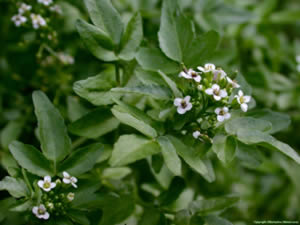Watercress Herbal and Edible Uses

Nasturtium officinale
Other Names: Brooklime, Brown Cress, Cress, Cresson, Nasturtium, Water Cresses, True Watercress, Watercress
Watercress is an edible plant, exceptionally rich in vitamins and minerals. It has long been valued as a food and herbal plant. Watercress has a mildly hot mustard flavor, very good fresh in salad or on a sandwich or cooked as a pot herb. The seed is ground into a powder and used as a mustard.
As a herb, Watercress is used in alternative medicine as an antiscorbutic, depurative, diuretic, expectorant, purgative, hypoglycemic, odontalgic, stimulant, tonic and stomachic. Culpepper says that the leaves bruised or the juice will free the face from blotches, spots and blemishes, when applied as a lotion.
Other plant constituents in Watercress, such as Arginine, Aspartic-acid, Beta-carotene, Biotin, Folacin, Glutamic-acid, Glycine, Histidine, Isoleucine, Lysine, Methionine, Pantothenic-acid, Phenylalanine, Serine, Threonine, Tryptophan, Tyrosine, and Valine, indicate that this plant may be useful for many other conditions. Further research needs to be done.
Considered a cleansing herb, Watercress has a high content of vitamin C which makes it a remedy that is particularly valuable for chronic illnesses. The plant has been used as a specific in the treatment of tuberculosis. The freshly pressed juice of Watercress has been used internally and externally in the treatment of chest and kidney complaints. A poultice of the leaves is said to be an effective treatment for healing glandular tumors or lymphatic swellings and chronic irritations and inflammations of the skin.
Watercress Native Habitat and Description
Watercress is a wide spread, perennial herb. There is some question as to whether or not True Watercress is native. Watercress is found growing in open running watercourses or near cool shallow springs, spring holes, spring fed stream margins, and brooks.
How to Grow Watercress
Watercress is fairly easy to cultivate, it prefers to grow in cool, flowing, water about 2 to 3 inches deep, in a partially shaded area. Sow seed spring in a pot emerged to half its depth in water. Cuttings can be taken at any time in the growing season. Virtually any part of the plant, put it in a container of water until the roots are well formed and then plant out in shallow water. A fast-growing plant, the flowers are a rich source of pollen and so are very attractive to bees.
Watercress Folklore and History
The ancient Greek general, and the Persian King Xerxes ordered their soldiers to eat Watercress to keep them healthy. The Greeks additionally believed that "Eating cress makes one witty". Applied externally, Watercress has a long-standing reputation as an effective hair tonic, helping to promote the growth of thick hair.
Article and Herb Pictures by Deb Jackson & Karen Bergeron. Copyright 1998
- 2015
All rights reserved.



